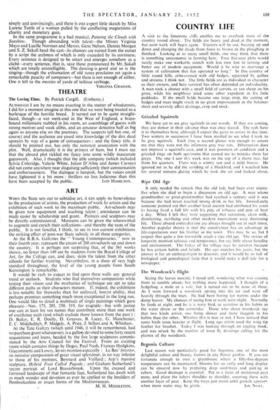ART
WHEN the. State sets out to subsidise art, it can apply its benevolence to the production of artists, the production of work by artists and the exhibition of such work to the maximum public. Art-schools may be given new equipment and teaching talent ; attendance can be made easier by scholarship and grant. Painters and sculptors may be directly commissioned. Museums can be given the wherewithal to augment and enrich their collections—and thereby the taste of the public. It is not fanciful, I think, to see in two current exhibitions the striking effect of post-war State subsidy in all three categories.
At the R.B.A. Galleries the " Young Contemporaries," now in their fourth year, represent the cream of 200 art-schools up and down the country. It is perhaps not surprising that, of the 561 works shown, no fewer than 149 are by students from the Royal College of Art, for the College can, and does, skim the talent from the other schools for further training. Nevertheless, in a show of very high standard throughout, the level of the young people from South Kensington is remarkable. It would be rash to expect to find upon these walls any general trend or outlook. Students who find themselves companions while testing their vision and the mechanics of technique are apt to take different paths as their characters mature. If, indeed, the exhibition is less notable for fireworks than for unforced, honest ability, that perhaps promises something much more exceptional in the long run. One would like to detail a multitude of single paintings which gave pleasure—Nos. 175, 205, 250, 319, for exapple—but with justice one can at least list ten names that contribute more than one work of excellence each (and which exclude those known from the past ) : D. Bailey, E. R. Doelly, D. Greaves, B. Lacey, G. Manchester, E. C. Middleditch, P. Midgely, A. Price, J. Sellars and A. Whishaw.
At the Tate Gallery (which until 1946, it will be remembered, had no purchase grant whatsoever), is a gallery devoted to some forty recent acquisitions and loans, headed by the five large sculptures commis- sioned by the Arts Council for the Festival. From an exciting room which contains things by Degas, Paul Nash, Frances Hodgkins, Giacommetti and Lowry, let me mention especially : Le Bas' Interior, an intimiste composition of great visual splendour, in no way inferior to those of his mentors, Bonnard and Vuillard9 Arp's massive sculpture, Hybrid Fruit Called Pagoda ; and Graham Sutherland's recent portrait of Lord Beaverbrook. Upon the creased and furrowed landscape of that fantastic face, Sutherland has dwelt with as much wonder and devotion as ever he applied to the boulders of Pembrokeshire or insect forms of the Mediterranean.
M. H. MIDDLETON.


































 Previous page
Previous page